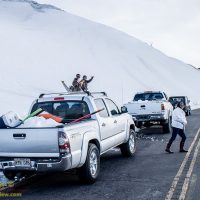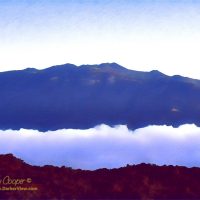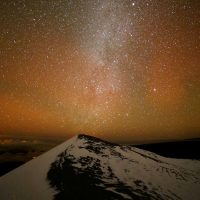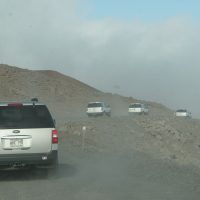The University of Hawaii and the Office of Mauna Kea Management have released the latest version of their proposed public access rules for Mauna Kea. Along with the release is an opportunity to comment on the new rules.
Public comment on the previously proposed rule package was so overwhelmingly negative that the university was forced to withdraw the rules for revision. As this is round two, shall we take a look at the revised public access rules?
These rules will govern all public and commercial access to the summit of Mauna Kea. As such these rules should be of intense interest of anyone who travels to Mauna Kea. All island residents should be made aware of the contents of these rules as the mauna belongs to all of those who live in its shadow.
The purpose of these rules is to formalize the contents of the Mauna Kea Comprehensive Management Plan and many of the provisions stem directly from the plan. While some of the rules may apply to all UH administered areas, many apply only to ‘north of Halepōhaku’.
A substantial portion of the rules are relatively non-controversial. Prohibitions on off-road driving, damaging state properly, disturbing historic sites, alcohol or illegal drug use, hazardous materials, and compliance with other state and local laws? We will skip over much of this material. It does seem redundant to even list many of these items in these rules as they are already covered elsewhere in state law, one must surmise that listing these items here insures that any enforcement action cannot be challenged on jurisdictional grounds.
Admittedly I am most closely examining those rules that would personally effect me or those that seem notably controversial. I expect many of those who might read this, photographers, amateur astronomers, and visitors to the mauna, may be interested in the same provisions.
I will ignore most of the commercial rules in this post. From what I have read these rules formalize what is already normal practice for commercial tours on the mauna.
That being said, let us proceed with an in-depth analysis of the proposed rules. I intend to examine the newly proposed rules. While they are much better than the previously proposed rule package, they do have some issues that should be considered more closely.
There is a lot to cover here, I apologize as this is a very lengthy post!
Access Hours
For many the idea of public access hours is one of the most contentious issues in the rules. Oddly the rules do not specify the hours, rather they refer to the comprehensive management plan.
§20-26-38 Access. (a) Roadway access control. Upon approval of the board of land and natural resources, a gate or other access control structure may be installed as set forth in the comprehensive management plan to manage vehicular access to portions of the UH management areas.
Proposed Mauna Kea Public Access Rules, 2Jan2019 version
(c) Closed areas, public access hours. Public access hours for the UH management areas shall be adopted as set forth in the comprehensive management plan, provided that hunting shall be allowed pursuant to department of land and natural resources hunting rules. All persons shall abide by the officially posted signs designating public access hours.
The CMP Public Access Plan specifies access to the science reserve during the hours of “½ hour before sunrise to ½ hour after sunset” in table 2-4, eliminating any access during the hours of true darkness.
The idea of access hours drew particular attention from cultural practitioners, noting that protocols may demand observing stars rising or setting, or other after-dark or pre-dawn observations. While cultural practice may be exempt from these rules, there remains the problem of determining who is, and who is not a practitioner, placing an impossible decision on any enforcement official.
There are two obvious motivations for this prohibition. First is the risk anyone might encounter when on the summit at night, and the lack of help should an issue occur, the ranger’s last patrol is just after sunset. The second is any possible interference with the operation of the observatories due to headlights or other issues.
The interference issue is neatly handled with section §20-26-23 that prohibits any interference with the observatories. There is no need for further restrictions on that point.
Safety is neatly addressed through the environment of the mauna itself. For anyone unprepared the summit is a cold, unwelcoming place at night, often quite miserable. Today, when nighttime access if effectively unlimited, there are very few who choose to stay very long. Those that do are more prepared for the conditions and generally not likely to encounter trouble.
Cultural practitioners, photographers, hikers, amateur astronomers, there are many who go to the mauna outside of daylight hours. While there are some risks in doing so, those risks can be minimal for anyone properly prepared to do so.
Private Vehicles
Another very contentious issue regards restrictions on the use of private vehicles to access the summit. Restricting private vehicles is a very strong form of control on the mauna.
§20-26-38 Access. (a) Roadway access control. Upon approval of the board of land and natural resources, a gate or other access control structure may be installed as set forth in the comprehensive management plan to manage vehicular access to portions of the UH management areas.
Proposed Mauna Kea Public Access Rules, 2Jan2019 version
…
(2) Access by private vehicles may be restricted for public safety and welfare, for the protection of resources, and to reduce congestion. Restrictions may include, but are not limited to, setting a maximum number of private vehicles allowed within the UH management areas at a time, restricting the areas in which private vehicles may operate, or utilizing shuttle vehicles in lieu of private vehicles.
The number of vehicles accessing the summit is a major concern on the mauna. Since the completion of the Saddle Road renovations the number of vehicles coming to the mountain has steadily increased. This is particularly apparent in the evening, with many tourists coming to watch sunset or attend the evening stargazing at the visitor center.
Limiting the maximum number of visitors attending the evening events is probably a necessary change, Implementing a reservation system as is now used by the Park Service for sunrise on Haleakala would be an effective management plan. Limiting private vehicle access altogether is far more controversial.

The local community looks upon Mauna Kea as their mauna, this is no more apparent than on a snow day. When a substantial amount of fresh snow appears it is an island tradition to head up to enjoy Poliʻahu’s blessing. These days can see hundreds of vehicles on the summit road, including dozens of pickup trucks full of snow heading down to provide snow to those who do not come up.
If the University were to do anything that interfered substantially with community access to the mauna it would certainly create enormous discontent within the island community.
Without the freedom of movement a vehicle represents the university would effectively eliminate access to large section of the managed areas as access would become vastly more difficult. Do you want to take photos of the VLBA, or hike to the adze quarry? Do you want to take starscape photos of the AO lasers working at night? This is not going to happen without a personal vehicle available.
The shuttle idea has likewise been proposed as a solution. Some form of scheduled shuttle service running from Halepōhaku to the summit. The issue here is in the details. The shuttle would likely only stop at designated places and run on limited hours. This too would eliminate effective access to huge areas of the mountain.
Any shuttle service may likely involve a fee and limits to passenger volume. This could also create strong objections in the local community. Fees that seem trivial to a tourist family may very well be prohibitive to a local family struggling with an already high cost of living further damaging the Universityʻs relationship with the local community.
Interference with the Observatories
This is a section that saw substantial revision from the first draft, and was greatly improved as a result. It was nice to see the public input have a beneficial effect in the rule making process.
§20-26-23 Preservation of scientific and educational resources. The following activities are prohibited within the UH management areas north of Halepōhaku:
Proposed Mauna Kea Public Access Rules, 2Jan2019 version
(1) Using any radio transmitter, including but not limited to two-way radios, Wi-Fi and Bluetooth devices, and cellular telephones; provided that, cellular telephones may be used for emergency purposes or when radio transmission is suspended, for example by using airplane mode;
(2) Directing artificial illumination, for example, lasers and flashlights, at or near observatories; or
(3) Conducting any other activity that materially interferes with the scientific and educational operations of the astronomical facilities or research equipment or with the protection of the scientific resources.
The first version prohibited any use of artificial illumination, a gross safety hazard. This revised version is properly limited in scope to direct interference with the observatories.
4WD Vehicles
While previous versions of the rules specified that only low-range 4WD vehicles be allowed above Halepōhaku, the latest version simply prohibits 2WD vehicles on the summit road. This seems to allow full time 4WD and all-wheel drive vehicles without the low-range gear feature.
§20-26-28 Vehicles and transportation. (a) The following acts are prohibited within the UH management areas:
Proposed Mauna Kea Public Access Rules, 2Jan2019 version
(8) Use of two-wheel drive motorized vehicles north of Halepōhaku.
The new prohibition is baffling as so many modern passenger vehicles are all-wheel drive. It is these lightly built passenger vehicles that present the most risk when faced with the thin air and steep grades.
The new 2WD prohibition seems to indicate that the desire is simply limiting traffic on the mauna by excluding many possible vehicles rather than a genuine concern for the safety of any particular vehicle.
Obstruction and Behavior
This is a provision certain to see a great deal of objection from those wishing to protest telescope construction.
§20-26-34 Public safety. The following acts are prohibited within the UH management areas:
Proposed Mauna Kea Public Access Rules, 2Jan2019 version
(1) Disorderly conduct, as defined in section 711-1101, Hawai‘i Revised Statutes; or
(2) Engaging in activities that would obstruct or impede public or vehicular access, or harass visitors to UH management areas, either verbally or with physical contact.
Due to the withdrawal of the first rule package for revision, it seems unlikely that these rules will be in place before construction begins on the Thirty Meter Telescope.
Bicycles
Oddly a prohibition on pedal powered vehicles above Halepōhaku appeared in the latest draft. This prohibition does not appear in earlier revisions.
§20-26-30 Outdoor sports activities. The following acts are prohibited within the UH management areas:
Proposed Mauna Kea Public Access Rules, 2Jan2019 version
(1) Use of vehicles with two wheels propelled by pedals, for example, a bicycle, north of Halepōhaku;
I fail to see the hazard here. Yes, even though the road is rough and steep, we regularly see bicycles ascending the summit, we have even seen a unicycle make the ascent! I am not aware of any serious bicycle related incidents in my years on the mauna. Without explanation this just seems the be another case of overreach in these rules, one that may draw some intense criticism from the island sports community.
Drones and Air Toys
Several rules seem to be a simple bureaucratic overreaction to perceived and likely unjustified fears, a desire for control. Without a reasonable justification for those fears one is left wondering why a prohibition appears in these rules. The banning of bicycles discussed above is a good example, as is the prohibition against the use of ‘air toys’ as found in rule 29…
§20-26-29 Unmanned aerial vehicles, drones and air toys. The following acts are prohibited within the UH management areas: using or operating unmanned or remote controlled terrestrial vehicles, aerial vehicles, drones, or air toys, including but not limited to kites, balloons, boomerangs, gliders, rockets, and model aircraft.
Proposed Mauna Kea Public Access Rules, 2Jan2019 version
Drones have obviously been singled out due to a general public fear of these devices, often due to hysterical overreactions to the new technology. But kites? What is wrong with flying a kite? Can we get some reasonable justification here?
Snow Play
As discussed in the section on private vehicles above, a good winter storm will bring a large segment of the community to the summit to enjoy the snow. Again the University needs to be quite careful here as any restrictions can be seen very negatively by the community.
§20-26-39 Snow play. (a) Skiing, snowboarding, sledding and other similar winter or snow sports may be restricted to maintain public safety and welfare, to prevent damage to resources, and to minimize conflicts among visitors. The use of devices that are not equipped with braking mechanisms or which do not provide directional control on snow or ice is prohibited.
Proposed Mauna Kea Public Access Rules, 2Jan2019 version
(b) Skiing, snowboarding, sledding or other forms of snow recreation or snow activities may be prohibited in specific designated zones or areas in order to maintain public safety and welfare, and protect resources.
The rules do not prohibit snow play, but do offer possible restrictions to where such activity may occur. The rules go on to prohibit any sort of informal or formal competitions, tours, and the use of any snowmobiles or towing.
There is another possible danger here. If snow play is limited to a specific area the University runs the risk of have this area seen as a “safe” place, a form of endorsement or clearance. This may be a complication when the inevitable injury occurs in this area and a lawsuit ensues.
Building or Construction
Another lightning rod in the access rules is a prohibition against building any structure without a DLNR permit. While cultural access is handled by the separate Cultural Resources Management Plan any rule that may be seen as impinging on the same territory will be subject to criticism from the community.
§20-26-21 Preservation of resources. The following activities are prohibited within the UH management areas:
Proposed Mauna Kea Public Access Rules, 2Jan2019 version
(9) Engaging in any improvement or construction, except as authorized by written permit and, if applicable, a permit issued by the department of land and natural resources, or by the board of land and natural resources;
This prohibition is certain to draw the ire of cultural practitioners. While traditional practices are protected by the Hawaii constitution and by any number of laws addressing the issue, determining who is, and who is not, covered by those laws has led to a plethora of court cases. University policy up to this point has been to allow some construction of ahu or other religious structures, while others, deemed to be inappropriate have been removed after an ill-defined period of time.
Given the highly fragmented and often personal nature of Hawaiian religious practice there is little agreement as to what is and what is not appropriate, even among the various practitioners on the mauna. If someone constructed a ten foot purple pyramid on the mauna? Yeah, probably not appropriate. Constructing a small personal or family ahu? An often argued point.
Traditionally one wishing to utilize resources, or go into a sacred place, would have requested permission from the appropriate konohiki or kahuna. It seems to make sense that someone who wished to construct or repair a religious structure on the mauna might be asked to consult the Kahu Kū Mauna council first. However, given the adversarial stance of many cultural practitioners at this point it seems that any agreement on these matters is unlikely.
Summary
In general I support the rule making process, a decent set of public access rules are needed, commercial rules even more so.
These rules are far better than what we saw previously, but still leave some questions. In general the rules have instances of being overly expansive with some unexplained and seemingly unneeded prohibitions.
If you are connected to the mauna in any way I would strongly suggest you read and consider the rules for yourself and take advantage of the opportunity to submit comment and to participate in the public hearings that will follow. The comment period runs until March 15th.






A very concise summary of the proposed rules andrew. Well done. The part about nite time use, skiing and kites disturbs me ,and i will give testimony to the point. As in a democratic assembly we have a voice, speak ur mind and maybe u will be heard.
Hi to Deb
Aloha